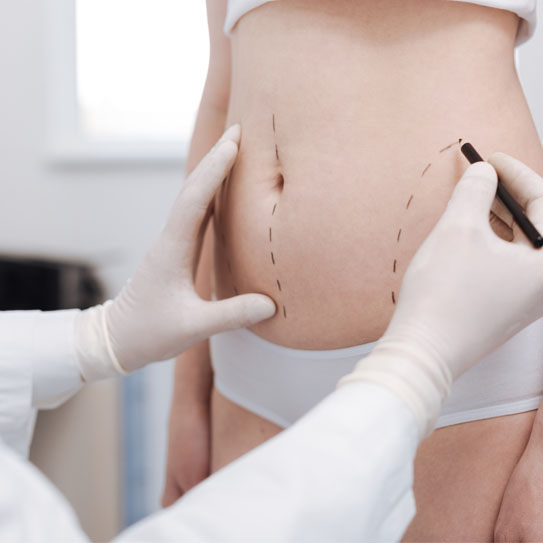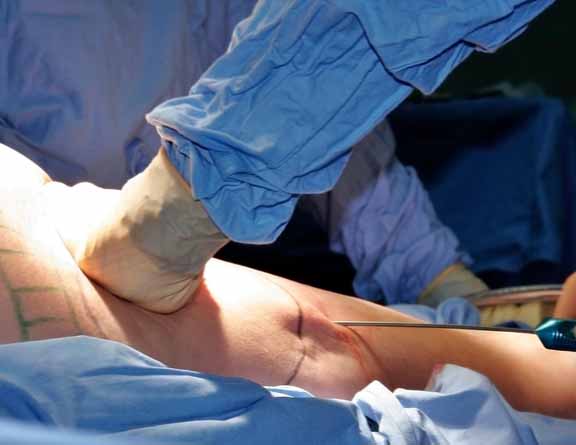
విజయవాడ
USFDA-Approved Procedures
Confidential Consultation
No-Cost EMI
1-day Hospitalization


చికిత్స
ప్రక్రియ సమయంలో వైద్యులు ఉపయోగించగల వివిధ లిపోసక్షన్ పద్ధతులు ఉన్నాయి.
ఈ టెక్నిక్లో, వైద్యుడు ముందుగా కొవ్వు ప్రాంతాన్ని తగ్గించడానికి కొన్ని రసాయనాలతో సెలైన్ ద్రావణాన్ని లోపలికి పంపిస్తాడు.
వైద్యుడు ఎలాంటి ద్రవాలను ఇంజెక్ట్ చేయకుండా అవాంఛిత కొవ్వును బయటకు తీస్తాడు.
కోతలు చేసిన తర్వాత, కొవ్వును విచ్ఛిన్నం చేయడానికి సహాయపడే అల్ట్రాసౌండ్తో కాన్యులా శక్తినిస్తుంది. ఈ పద్ధతి కొవ్వును బయటకు తీయడాన్ని చాలా సులభతరం చేస్తుంది.
ప్రత్యేక కాన్యులా(cannula) సహాయంతో, సర్జన్ శరీరం నుండి అదనపు కొవ్వును తొలగిస్తాడు.
కాన్యులా ద్వారా, ఒక చిన్న ట్యూబ్ చొప్పించబడుతుంది, దీనిలో నుంచి లేజర్ శక్తి విడుదల అవుతుంది. ఇది చర్మం కింద ఉన్న కొవ్వును వేడి చేస్తుంది మరియు కొవ్వును సులభంగా తొలగిస్తుంది.
VASER లేదా వైబ్రేషన్ యాంప్లిఫికేషన్ ఆఫ్ సౌండ్ ఎనర్జీ ఎట్ రెసొనెన్స్ టెక్నిక్ అవాంఛిత కొవ్వు కణాలను విచ్ఛిన్నం చేయడానికి అల్ట్రాసౌండ్ తరంగాలపై ఆధారపడుతుంది.
విజయవాడలొని ప్రిస్టిన్ కేర్ నందు, మేము ప్రాథమికంగా VASER మరియు లేజర్ లైపోసక్షన్ పద్ధతులను ఉపయోగిస్తాము. అయితే, అవసరమైనపుడు, మేము ఉత్తమ ఫలితాలను అందించడానికి ట్యూమెసెంట్, పవర్ అసిస్టెడ్, డ్రై మరియు వెట్ లిపోసక్షన్ టెక్నిక్లను కూడా ఉపయోగిస్తాము.
సాధారణంగా, ప్రక్రియ క్రింది విధంగా నిర్వహించబడుతుంది:
మా వైద్యులు లైపోసక్షన్ను మచ్చలేని చికిత్సగా చేయడానికి చాలా చిన్న కోతను చేస్తారు. చికిత్సకు సంబంధించిన ప్రతి విషయాన్ని వివరంగా చర్చించడానికి మీరు మా వైద్యులతో అపాయింట్మెంట్ని షెడ్యూల్ చేసుకోవచ్చు.
Delivering Seamless Surgical Experience in India
థర్మల్ స్క్రీనింగ్, సోషల్ డిస్టెన్సింగ్, శానిటైజ్డ్ క్లినిక్లు మరియు హాస్పిటల్ రూమ్లు, స్టెరిలైజ్డ్ సర్జికల్ ఎక్విప్మెంట్ మరియు సర్జరీ సమయంలో తప్పనిసరి PPE కిట్ల ద్వారా మీ భద్రతను చూసుకుంటారు.
A dedicated Care Coordinator assists you throughout the surgery journey from insurance paperwork, to commute from home to hospital & back and admission-discharge process at the hospital.
మీ పరిస్థితిని నిర్ధారించడానికి మా సర్జన్లు మీతో చాలా సమయం గడుపుతారు. శస్త్రచికిత్సకు ముందు జరిగే అన్ని మెడికల్ డయాగ్నస్టిక్స్లో మీకు సహాయం అందుతుంది. మేము అధునాతన లేజర్ మరియు లాపరోస్కోపిక్ శస్త్రచికిత్స చికిత్సను అందిస్తున్నాము. మా విధానాలు USFDA ఆమోదించబడ్డాయి.
We offer follow-up consultations and instructions including dietary tips as well as exercises to every patient to ensure they have a smooth recovery to their daily routines.
కొన్ని సందర్భాల్లో, లైపోసక్షన్ రోగులకు ప్రాణాంతకం కలిగించే సమస్యలకు దారితీస్తుంది. ఇది జరగకుండా నిరోధించడానికి, లైపోసక్షన్ ద్వారా నిర్దిష్ట మొత్తంలో కొవ్వు మాత్రమే తొలగించబడుతుందని మరియు అనుభవజ్ఞుడైన సర్జన్ మాత్రమే శస్త్రచికిత్స చేయగలరని నిర్ధారించడానికి అనేక చట్టాలు ప్రత్యేకంగా ఉంచబడ్డాయి.
విజయవాడలొ ప్రిస్టిన్ కేర్u200c నందు మా వైద్యులు తాజా లేజర్ మరియు VASER (ప్రతిధ్వని వద్ద సౌండ్ ఎనర్జీ యొక్క వైబ్రేషన్ యాంప్లిఫికేషన్) పద్ధతులను ఉపయోగించి వీలైనంత సురక్షితమైన మార్గంలో కొవ్వును తొలగిస్తారు. ఈ పద్ధతులతో పాటు, మా వైద్యులు ఖచ్చితమైన ఫలితాలను అందించడానికి అవసరమైనప్పుడు సంప్రదాయ లిపోసక్షన్, ట్యూమెసెంట్ లైపోసక్షన్ మరియు ఇతర పద్ధతులను కూడా ఉపయోగిస్తూవుంటారు.
విజయవాడలొ ప్రిస్టిన్ కేర్ వైద్యుల సంరక్షణలో లైపోసక్షన్ సర్జరీకి దాదాపు రూ. 75,000 నుండి రూ. 2,00,000 ఉంటుంది,ఇది లక్షిత ప్రాంతాలు మరియు తీసివేయవలసిన కొవ్వు పరిమాణంపై ఆధారపడి ఉంటుంది. అయినప్పటికీ, వివిధ కారకాలపై ఆధారపడి తుది ఖర్చు రోగి నుండి రోగికి మారుతూ ఉంటుంది కాబట్టి ఇది కేవలం అంచనా మాత్రమే.
కింది కారకాలపై ఆధారపడి లైపోసక్షన్ ఖర్చు గణనీయంగా మారుతుంది:తొలగించాల్సిన కొవ్వు మొత్తంలక్ష్యంగా చేసుకున్న ప్రాంతాల సంఖ్యసర్జన్ ఫీజురోగనిర్ధారణ పరీక్షలుప్రక్రియతో సంబంధం ఉన్న ప్రమాదాలు మరియు సమస్యలుచికిత్సకు ఎంచుకున్న టెక్నిక్శస్త్రచికిత్సకు ముందు మరియు తరువాత మందులుశస్త్రచికిత్స అనంతర సంరక్షణ మరియు ఫాలో అప్u200c చర్యలు ఈ అన్ని కారణాల వల్ల, తుది ఖర్చు ఒక రోగికి మరొకరికి మారుతుంది.
లైపోసక్షన్ చికిత్స శాశ్వత ఫలితాలను అందిస్తుంది, ఎందుకంటే కొవ్వు నిల్వలు మిగిలి ఉండవు కాబట్టి. శస్త్రచికిత్స సమర్థవంతంగా కొవ్వును తొలగిస్తుంది మరియు మళ్లీ డిపాజిట్ చేయకుండా నిరోధిస్తుంది. మీరు డాక్టర్ సలహాను సరిగ్గా అనుసరించినట్లయితే, మీరు చాలా కాలం పాటు లైపోసక్షన్ యొక్క ఫలితాలను ఆనందించవచ్చు.
లిపోసక్షన్ సర్జరీ తర్వాత కోలుకోవడానికి చికిత్స కోసం ఉపయోగించే టెక్నిక్ రకాన్ని బట్టి సుమారు 1 నెల మాత్రమే పడుతుంది. కండరాలను ఉంచడానికి మరియు వాపును తగ్గించడానికి మీరు 1 లేదా 2 నెలల పాటు కుదింపు వస్త్రాన్ని(compression garment) ధరించాల్సి ఉంటుంది. పూర్తిగా కోలుకోవడానికి దాదాపు 1 నెల సమయం పట్టినప్పటికీ, మీరు తదుపరి కొన్ని రోజుల్లో సాధారణ కార్యకలాపాలను తిరిగి ప్రారంభించగలరు.
లైపోసక్షన్ ఫలితాలు కనిపించడానికి దాదాపు 1 3 నెలలు పడుతుంది అలాగే మీరు ఆరోగ్యకరమైన మరియు చురుకైన జీవనశైలిని అనుసరించినంత కాలం ఉంటుంది. శస్త్రచికిత్స తర్వాత, ఫలితాలు ఎక్కువ కాలం ఉండేలా డాక్టర్ మీ కోసం ఒక వివరణాత్మక ప్రణాళికను రూపొందిస్తారు. మీరు మంచి అలవాట్లను అభ్యసిస్తే మరియు ఆరోగ్యకరమైన జీవనశైలిని ఎంపిక చేసుకుంటే, మీరు 10 సంవత్సరాలు లేదా అంతకంటే ఎక్కువ కాలం పాటు లైపోసక్షన్ యొక్క ఫలితాలను ఆస్వాదించవచ్చు.
లైపోసక్షన్ మచ్చలు తక్కువగా ఉంటాయి మరియు దానికి సంభవించేవి దాదాపు కనిపించవు. ఈ మచ్చలు చిన్న చుక్కలు లేదా చిన్న చిన్న మచ్చలు వలె కనిపిస్తాయి, అవి రాబోయే కొద్ది నెలల్లో మాయమవుతాయి. మీరు తుది ఫలితాలను సాధించే సమయానికి, మచ్చలు కూడా అదృశ్యమవుతాయి, తద్వారా లైపోసక్షన్ మచ్చలేని చికిత్సగా మారుతుంది.
మీరు మీ చికిత్స సమయంలో లేదా స్పెర్మ్ రిట్రీవల్ తర్వాత వేరే నగరం లేదా రాష్ట్రానికి మారినట్లయితే, మీ నమూనాను వేరే ప్రదేశానికి తరలించడానికి మీరు స్పెర్మ్ బ్యాంక్u200cలతో చర్చ చేయవచ్చు.
శరీరం యొక్క రూపాన్ని మెరుగుపరచడంతో పాటు, లైపోసక్షన్ అనేక వైద్య పరిస్థితులకు కూడా చికిత్స చేయవచ్చు. ఇవి క్రింద వివరించబడ్డాయి
ప్రాణాంతక పరిస్థితులకు గురయ్యే అవకాశం ఉన్న ఊబకాయం ఉన్న వ్యక్తులు వారి బాడీ మాస్ ఇండెక్స్ లేదా BMIలో 40 శాతానికి చేరుకోవడానికి లైపోసక్షన్ చేయించుకోవడం గురించి ఆలోచించాలి.
లిపోసక్షన్ చికిత్సకి సరిపోయే అభ్యర్థులు:
ప్రక్రియకు ముందు కీలకమైన దశ సరైన క్లినిక్ను కనుగొనడం. గుర్తుంచుకోండి, మీరు లైపోసక్షన్ యొక్క పరిణామాలను శాశ్వతంగా భరించవలసి ఉంటుంది. అందువల్ల, సరైన క్లినిక్ హౌసింగ్ నుండి ,అత్యంత అనుకూలమైన వైద్యుడితో చికిత్స పొందడం అనేది ప్రాథమికంగా దృష్టిలో ఉండాలి.
కొన్ని సార్లు, లైపోసక్షన్ ప్రక్రియకు ముందు సరైన ప్రశ్నలను అడగడం రోగికి కష్టమవుతుంది.సంప్రదింపుల సమయంలో మీ వైద్యుడిని అడిగే కొన్ని సాధారణ ప్రశ్నలు ఇక్కడ ఉన్నాయి
తయారీ అనేది లైపోసక్షన్ యొక్క అంతర్భాగం, ఇది తరచుగా రోగులు సరిగ్గా అనుసరించడంలో విఫలమవుతుంది. లిపోసక్షన్ ప్రక్రియకు ముందు తీసుకోవాల్సిన కొన్ని సన్నాహక చర్యలు ఇక్కడ ఉన్నాయి.
లైపోసక్షన్ యొక్క దశల వారీ విధానం ఇక్కడ ఉంది
శస్త్రచికిత్సను ప్రారంభించడానికి, నొప్పి లేదా అసౌకర్యం లేదని నిర్ధారించుకోవడానికి రోగికి సాధారణ లేదా స్థానిక అనస్థీషియా ఇవ్వబడుతుంది.
డాక్టర్ అనేక చిన్న కోతలు చేయడం ద్వారా శస్త్రచికిత్సని ప్రారంభిస్తాడు. దీని ద్వారా, సెలైన్ ద్రావణం మరియు మత్తుమందు మిశ్రమం కొవ్వు ప్రదేశంలోకి ఇంజెక్ట్ చేయబడుతుంది.
లైపోసక్షన్ కోసం వ్యక్తి నిర్ణయించుకున్న సాంకేతికత రకాన్ని బట్టి, డాక్టర్ ఈ క్రింది దశను తీసుకుంటాడు.
కొవ్వు కణాలు వేడి ద్వారా లేదా కదలిక ద్వారా లేదా సెలైన్ ద్రావణం కారణంగా విరిగిపోతాయి, రకాన్ని బట్టి, ద్రవ రూపంలోకి వస్తాయి.
గొట్టాలు లేదా మరొక కాన్యులా సహాయంతో, డాక్టర్ అధిక కొవ్వును బయటకి లాగుతాడు. కుట్లు లేదా కరిగిపోయే జిగురుతో కోతలను మూసివేయడం ద్వారా ఇది పూర్తవుతుంది.
లైపోసక్షన్ అనేది పెద్ద శస్త్రచికిత్స.ఇతర ఏ శస్త్రచికిత్సా ప్రక్రియ మాదిరిగానే, ఇది కొన్ని దుష్ప్రభావాలు మరియు సమస్యలను కలిగిస్తుంది. ఇక్కడ చూడవలసిన కొన్ని సాధారణ ప్రమాదాలు ఉన్నాయి
సాధారణంగా, రోగులు కోలుకున్న రెండవ రోజునుంచే వారి రోజువారీ జీవితాన్ని తిరిగి ప్రారంభించవచ్చు. అయితే, ఒక వారం పాటు సరైన విశ్రాంతి తీసుకుని, మళ్లీ పనిలో చేరడం మంచిది. పూర్తి రికవరీ సుమారు 4 వారాలు పడుతుంది. కొన్ని సందర్భాల్లో, ఇది మరింత పట్టవచ్చు.
లైపోసక్షన్స్ యొక్క పూర్తి ప్రయోజనాలను పొందాలంటే, 21 రోజుల మొత్తం రికవరీ వ్యవధిలో చాలా జాగ్రత్తగా ఉండటం ముఖ్యం. రికవరీ పూర్తిగా సంక్లిష్టత లేనిదని మరియు ఛాతీ యొక్క సౌందర్య రూపాన్ని మీరు కోరుకున్నట్లు ఉండేలా చూసుకోవడానికి దిగువ పేర్కొన్న పునరుద్ధరణ చిట్కాలను అనుసరించండి:
రోగుల సేఫ్టీ మరియు సెక్యూరిటీ మాకు చాలా ముఖ్యమైనవి. అందువల్ల, మేము అవసరమైన అన్ని భద్రతా చర్యలను తీసుకుంటున్నాము మరియు COVID 19 సంక్రమణ వ్యాప్తిని అరికట్టడానికి ప్రభుత్వ అధికారులు పేర్కొన్న ప్రతి ప్రమాణాలను అనుసరిస్తున్నాము. ఇక్కడ కొన్ని భద్రతా చర్యలు ఉన్నాయి
విజయవాడలొ మా సర్జన్లు రోగి యొక్క అవసరాలను కీలకమైన అంశంగా ఉంచుతూ మొత్తం ప్రక్రియను ప్లాన్ చేస్తారు అలాగే అమలు చేస్తారు. శస్త్రచికిత్స అనవసరంగా ఆలస్యం కాకుండా చూసుకోవడానికి, మేము ప్రతి రోగికి ఈ క్రింది వాటిని అందిస్తాము
.svg)
.svg)